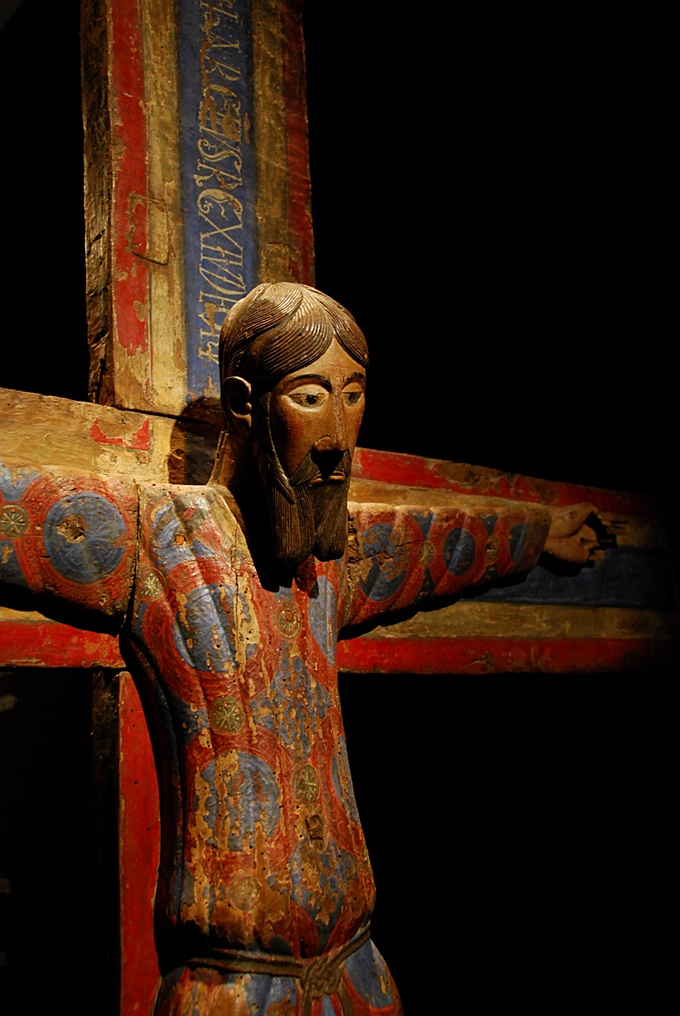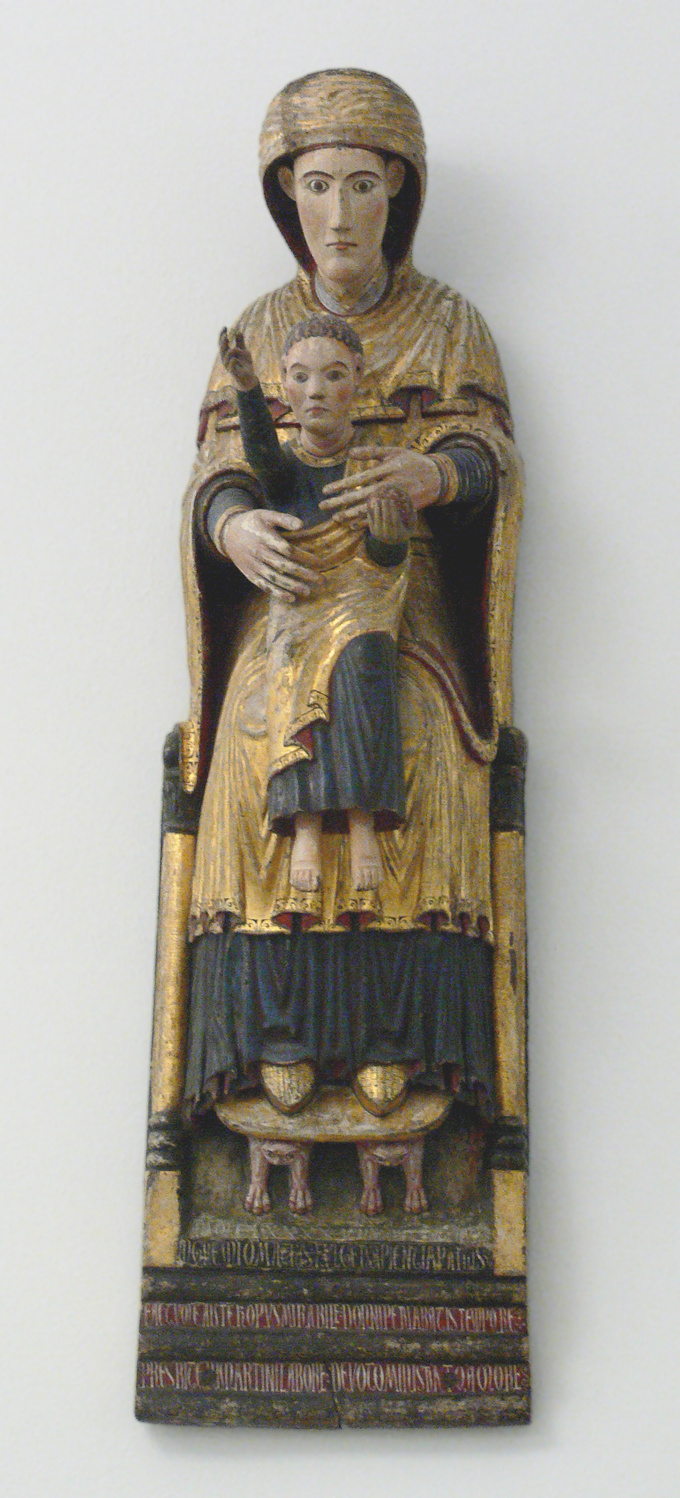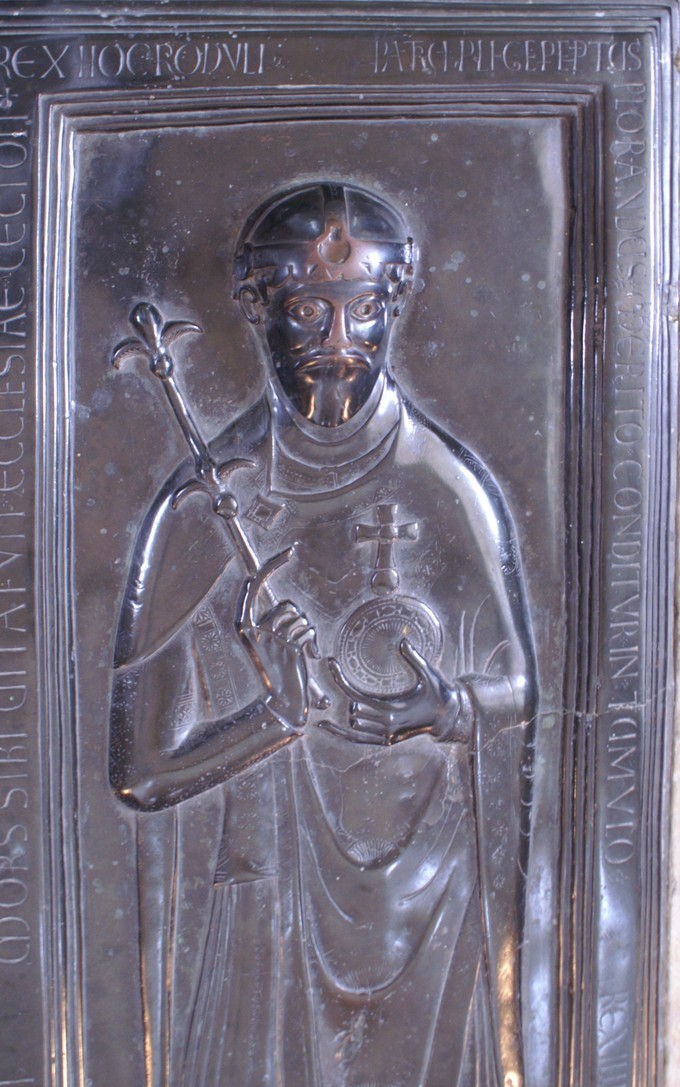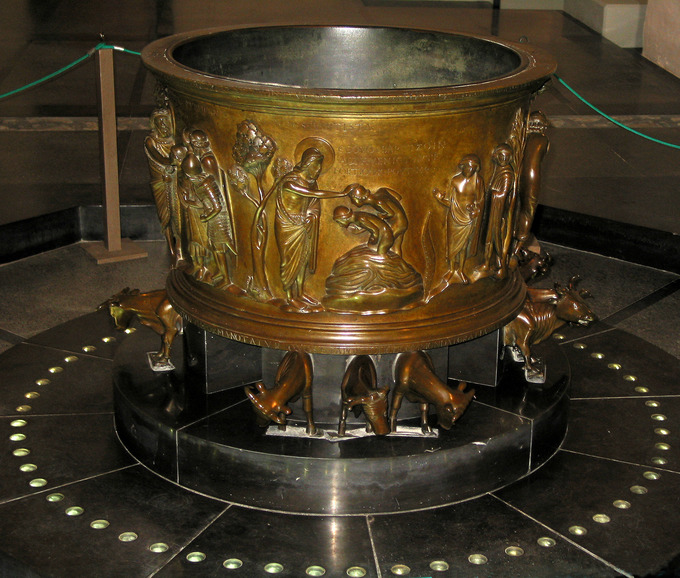17.3: Romanesque Sculpture
- Page ID
- 53048
\( \newcommand{\vecs}[1]{\overset { \scriptstyle \rightharpoonup} {\mathbf{#1}} } \)
\( \newcommand{\vecd}[1]{\overset{-\!-\!\rightharpoonup}{\vphantom{a}\smash {#1}}} \)
\( \newcommand{\dsum}{\displaystyle\sum\limits} \)
\( \newcommand{\dint}{\displaystyle\int\limits} \)
\( \newcommand{\dlim}{\displaystyle\lim\limits} \)
\( \newcommand{\id}{\mathrm{id}}\) \( \newcommand{\Span}{\mathrm{span}}\)
( \newcommand{\kernel}{\mathrm{null}\,}\) \( \newcommand{\range}{\mathrm{range}\,}\)
\( \newcommand{\RealPart}{\mathrm{Re}}\) \( \newcommand{\ImaginaryPart}{\mathrm{Im}}\)
\( \newcommand{\Argument}{\mathrm{Arg}}\) \( \newcommand{\norm}[1]{\| #1 \|}\)
\( \newcommand{\inner}[2]{\langle #1, #2 \rangle}\)
\( \newcommand{\Span}{\mathrm{span}}\)
\( \newcommand{\id}{\mathrm{id}}\)
\( \newcommand{\Span}{\mathrm{span}}\)
\( \newcommand{\kernel}{\mathrm{null}\,}\)
\( \newcommand{\range}{\mathrm{range}\,}\)
\( \newcommand{\RealPart}{\mathrm{Re}}\)
\( \newcommand{\ImaginaryPart}{\mathrm{Im}}\)
\( \newcommand{\Argument}{\mathrm{Arg}}\)
\( \newcommand{\norm}[1]{\| #1 \|}\)
\( \newcommand{\inner}[2]{\langle #1, #2 \rangle}\)
\( \newcommand{\Span}{\mathrm{span}}\) \( \newcommand{\AA}{\unicode[.8,0]{x212B}}\)
\( \newcommand{\vectorA}[1]{\vec{#1}} % arrow\)
\( \newcommand{\vectorAt}[1]{\vec{\text{#1}}} % arrow\)
\( \newcommand{\vectorB}[1]{\overset { \scriptstyle \rightharpoonup} {\mathbf{#1}} } \)
\( \newcommand{\vectorC}[1]{\textbf{#1}} \)
\( \newcommand{\vectorD}[1]{\overrightarrow{#1}} \)
\( \newcommand{\vectorDt}[1]{\overrightarrow{\text{#1}}} \)
\( \newcommand{\vectE}[1]{\overset{-\!-\!\rightharpoonup}{\vphantom{a}\smash{\mathbf {#1}}}} \)
\( \newcommand{\vecs}[1]{\overset { \scriptstyle \rightharpoonup} {\mathbf{#1}} } \)
\(\newcommand{\longvect}{\overrightarrow}\)
\( \newcommand{\vecd}[1]{\overset{-\!-\!\rightharpoonup}{\vphantom{a}\smash {#1}}} \)
\(\newcommand{\avec}{\mathbf a}\) \(\newcommand{\bvec}{\mathbf b}\) \(\newcommand{\cvec}{\mathbf c}\) \(\newcommand{\dvec}{\mathbf d}\) \(\newcommand{\dtil}{\widetilde{\mathbf d}}\) \(\newcommand{\evec}{\mathbf e}\) \(\newcommand{\fvec}{\mathbf f}\) \(\newcommand{\nvec}{\mathbf n}\) \(\newcommand{\pvec}{\mathbf p}\) \(\newcommand{\qvec}{\mathbf q}\) \(\newcommand{\svec}{\mathbf s}\) \(\newcommand{\tvec}{\mathbf t}\) \(\newcommand{\uvec}{\mathbf u}\) \(\newcommand{\vvec}{\mathbf v}\) \(\newcommand{\wvec}{\mathbf w}\) \(\newcommand{\xvec}{\mathbf x}\) \(\newcommand{\yvec}{\mathbf y}\) \(\newcommand{\zvec}{\mathbf z}\) \(\newcommand{\rvec}{\mathbf r}\) \(\newcommand{\mvec}{\mathbf m}\) \(\newcommand{\zerovec}{\mathbf 0}\) \(\newcommand{\onevec}{\mathbf 1}\) \(\newcommand{\real}{\mathbb R}\) \(\newcommand{\twovec}[2]{\left[\begin{array}{r}#1 \\ #2 \end{array}\right]}\) \(\newcommand{\ctwovec}[2]{\left[\begin{array}{c}#1 \\ #2 \end{array}\right]}\) \(\newcommand{\threevec}[3]{\left[\begin{array}{r}#1 \\ #2 \\ #3 \end{array}\right]}\) \(\newcommand{\cthreevec}[3]{\left[\begin{array}{c}#1 \\ #2 \\ #3 \end{array}\right]}\) \(\newcommand{\fourvec}[4]{\left[\begin{array}{r}#1 \\ #2 \\ #3 \\ #4 \end{array}\right]}\) \(\newcommand{\cfourvec}[4]{\left[\begin{array}{c}#1 \\ #2 \\ #3 \\ #4 \end{array}\right]}\) \(\newcommand{\fivevec}[5]{\left[\begin{array}{r}#1 \\ #2 \\ #3 \\ #4 \\ #5 \\ \end{array}\right]}\) \(\newcommand{\cfivevec}[5]{\left[\begin{array}{c}#1 \\ #2 \\ #3 \\ #4 \\ #5 \\ \end{array}\right]}\) \(\newcommand{\mattwo}[4]{\left[\begin{array}{rr}#1 \amp #2 \\ #3 \amp #4 \\ \end{array}\right]}\) \(\newcommand{\laspan}[1]{\text{Span}\{#1\}}\) \(\newcommand{\bcal}{\cal B}\) \(\newcommand{\ccal}{\cal C}\) \(\newcommand{\scal}{\cal S}\) \(\newcommand{\wcal}{\cal W}\) \(\newcommand{\ecal}{\cal E}\) \(\newcommand{\coords}[2]{\left\{#1\right\}_{#2}}\) \(\newcommand{\gray}[1]{\color{gray}{#1}}\) \(\newcommand{\lgray}[1]{\color{lightgray}{#1}}\) \(\newcommand{\rank}{\operatorname{rank}}\) \(\newcommand{\row}{\text{Row}}\) \(\newcommand{\col}{\text{Col}}\) \(\renewcommand{\row}{\text{Row}}\) \(\newcommand{\nul}{\text{Nul}}\) \(\newcommand{\var}{\text{Var}}\) \(\newcommand{\corr}{\text{corr}}\) \(\newcommand{\len}[1]{\left|#1\right|}\) \(\newcommand{\bbar}{\overline{\bvec}}\) \(\newcommand{\bhat}{\widehat{\bvec}}\) \(\newcommand{\bperp}{\bvec^\perp}\) \(\newcommand{\xhat}{\widehat{\xvec}}\) \(\newcommand{\vhat}{\widehat{\vvec}}\) \(\newcommand{\uhat}{\widehat{\uvec}}\) \(\newcommand{\what}{\widehat{\wvec}}\) \(\newcommand{\Sighat}{\widehat{\Sigma}}\) \(\newcommand{\lt}{<}\) \(\newcommand{\gt}{>}\) \(\newcommand{\amp}{&}\) \(\definecolor{fillinmathshade}{gray}{0.9}\)Romanesque Sculpture
Sculpture from the Romanesque period saw advances in metalwork, enamels, and figurative friezes and scenes found in architecture.
Examine the characteristics of Romanesque sculpture
Key Points
- Romanesque art is the art of Europe from approximately 1000 CE to the rise of the Gothic style in the 13th century or later, depending on region.
- Sophisticated precious objects in metalwork , ivories , and enamels held high status in the Romanesque period.
- Many spectacular shrines made to hold relics have survived, such as the Shrine of the Three Kings at Cologne Cathedral by Nicholas of Verdun.
- Large reliquaries and altar frontals were built around a wooden frame, but smaller caskets were made entirely of metal and enamel. A few secular pieces such as mirror cases, jewelry, and clasps have also survived.
- During the 11th and 12th centuries, figurative sculpture was revived as architectural reliefs became a hallmark of the later Romanesque period. Figurative sculpture was based largely on manuscript illumination and small-scale sculpture in ivory and metal.
- Most Romanesque sculpture is pictorial and biblical in subject. A great variety of themes are found on building capitals , including scenes of Creation and the Fall of Man, the life of Christ, and the Old Testament.
Key Terms
- portal: An opening in a wall of a building, gate, or fortification, especially a grand entrance to an important structure.
- enamel: A material made by fusing powdered glass to a substrate by firing, usually between 750 and 850 °C (1,380 and 1,560 °F); the powder melts, flows, and then hardens to a smooth, durable vitreous coating on metal, glass, or ceramics.
- tympanum: In architecture, the semi-circular or triangular decorative wall surface over an entrance, bounded by a lintel and arch and often containing sculpture or other imagery or ornaments.
Background: Romanesque Art
Romanesque art is the art of Europe from approximately 1000 CE to the rise of the Gothic style in the 13th century or later, depending on region. The preceding period is known as the Pre-Romanesque period. The term was invented by 19th-century art historians specifically to refer to Romanesque architecture, which retained many features of Roman architectural style (notably round-headed arches , barrel vaults , apses , and acanthus-leaf decoration) while also developing distinctive characteristics. Southern France, Spain, and Italy showed architectural continuity with the Late Antique, but the Romanesque style was the first to spread across the whole of Catholic Europe from Sicily to Scandinavia. Romanesque art was also greatly influenced by Byzantine art, especially in painting, and by the anti-classical energy of the decoration of the Insular art of the British Isles. From these elements was forged a highly innovative and coherent style.
Romanesque Sculpture
Metalwork, Enamels, and Ivories
Precious objects in metalwork, ivories, and enamels held high status in the Romanesque period. The creators of these objects are more well-known than contemporary painters, illuminators, and architect-masons. Metalwork, including decoration in enamel, became very sophisticated. Many spectacular shrines made to hold relics have survived, of which the best known is the Shrine of the Three Kings at Cologne Cathedral by Nicholas of Verdun (circa 1180–1225). The bronze Gloucester candlestick is a superb example of metal casting , with intricate and energetic qualities that draw on manuscript painting. The Stavelot Triptych and Reliquary of St. Maurus are other examples of Mosan enamelwork. Large reliquaries and altar frontals were built around a wooden frame, but smaller caskets were made entirely of metal and enamel. A few secular pieces such as mirror cases, jewelry, and clasps have also survived, but these no doubt under-represent the amount of fine metalwork owned by the nobility.
The Gloucester candlestick, early 12th century: The bronze Gloucester candlestick is a superb example of metal casting, with intricate and energetic qualities that draw on manuscript painting.
Architectural Sculpture
With the fall of the Roman Empire, the tradition of carving large works in stone and sculpting figures in bronze died out, as it did for religious reasons in the Byzantine world. Some life-size sculpture was done in stucco or plaster, but surviving examples are rare. The best-known surviving sculpture of Proto-Romanesque Europe is the life-size wooden crucifix commissioned by Archbishop Gero of Cologne in about 960–65, apparently the prototype of a popular form . Beginning in the 12th centure, these were set up on a beam below the chancel arch, known in English as a rood, and flanked by figures of the Virgin Mary and John the Evangelist.
During the 11th and 12th centuries, figurative sculpture was revived as architectural reliefs became a hallmark of the late Romanesque period. Figurative sculpture was based largely on manuscript illumination and small-scale sculpture in ivory and metal. The extensive friezes sculpted on Armenian and Syriac churches were another likely influence. These sources together produced a distinct style that can be recognized across Europe, although the most spectacular sculptural projects are concentrated in South-Western France, Northern Spain, and Italy.
Images in metalwork were frequently embossed . The resulting surface had two main planes with incised details. This treatment was adapted to stone carving and is often seen in the tympanum above the portal , where the imagery of Christ in Majesty with the symbols of the Four Evangelists is drawn directly from the gilt covers of medieval gospel books. This style of doorway occurs in many places and continued into the Gothic period.
Most Romanesque sculpture is pictorial and biblical in subject. A great variety of themes are found on building capitals, including scenes of Creation and the Fall of Man, the life of Christ, and Old Testament depictions of his Death and Resurrection, such as Jonah and the Whale and Daniel in the lions’ den. Many Nativity scenes occur, most frequently the Three Kings. Some Romanesque churches feature an extensive sculptural scheme which covers the area surrounding the portal and sometimes much of the facade. The sculptural schemes were designed to convey the message that Christian believers should recognize wrongdoing, repent, and be redeemed. The Last Judgement reminds the believer to repent, while the carved or painted Crucifix, displayed prominently within the church, reminds the sinner of redemption.
Romanesque Sculpture: Majestat Batlló
The Batlló Majesty is one of the finest and best-preserved examples of Catalan sculptures from the 12th century.
Discuss the triumphant symbolism and Romanesque characteristics of the Batlló Majesty.
Key Points
- Carved wooden images were a fundamental element in churches as objects of worship. One of the most elaborate types in Catalonia was the Christ in Majesty: images of Christ on the Cross that symbolize his triumph over death.
- The most outstanding of these is the Majestat Batlló, also one of the finest and best-preserved examples of Catalan sculptures.
- One of the striking features of the Majestat Batlló compared to Catalan sculptures is the well-conserved polychromy .
- The frontal geometric composition of Christ’s tunic decorated in circles and floral motifs is reminiscent of the refined Byzantine and Hispano-Moorish fabrics held in high esteem in the Christian West during this time. The chronology of the Majestat Batlló is difficult to date; the inscription on the cross and the painting could be placed in the 11th century, although other authors date it back to the 12th century.
Key Terms
- polychromy: The practice of combining different colors, especially brilliant ones, in an artistic way.
- abacus: The uppermost portion of the capital of a column, immediately under the architrave.
- iconographic: Of or pertaining to a religious icon.
The Majestat Batlló, or Batlló Majesty, is a 12th century Romanesque polychrome wood carving now held in the Museu Nacional d’Art de Catalunya in Barcelona, Catalonia. Carved wooden images were a fundamental element in churches as objects of worship, and one of the most elaborate motifs was the Christ in Majesty: images of Christ on the Cross that symbolize his triumph over death. The most outstanding of these is the Majestat Batlló, also one of the finest and best-preserved examples of Catalan sculpture.

Symbolism and Description
The Majestat Batlló is a large wooden crucifix that presents Christ bearing his suffering with noble stoicism and triumph. He is wearing a colobium, or a long, sleeveless tunic. Although the corners of his mouth turn slightly downward, Christ’s open eyes and unfurrowed brow create the impression of a self-possessed impassivity. A Latin inscription above his head reads, “JHS NAZARENUS REX IUDEORUM” (“Jesus of Nazareth King of the Jews”), as in biblical accounts (Matthew 27:37, Mark 15:26, Luke 23:38, John 19:19).
One of the striking features of the Batlló Majesty compared to Catalan sculpture is the well-conserved polychromy. Christ’s colobium, in imitation of rich oriental silk, is decorated with blue floral designs surrounded by circular red frames embellished with dots and circles. A thin belt with an elaborate interlace knot pulls the tunic in above Christ’s hips, making the fabric above it swell out slightly and curving the path of its flat, wide vertical folds. Such robes are linked with royal and priestly functions and conveyed a message of strength to the audience. They can be seen as a visualization of the Apocalyptic Christ from the Book of Revelation.
The frontal geometric composition of the tunic decorated in circles and floral motifs is reminiscent of the refined Byzantine and Hispano-Moorish fabrics held in high esteem in the Christian West during this time. The great reference for this type was the Volto Santo in Lucca (Tuscany, Italy), regarded as having miraculous origins and as the object of pilgrimage and extraordinary devotion from the end of the 11th century. The iconographic tradition of Jesus in a colobium dates to 586 CE in a manuscript of the Syriac Gospels called the Rabbula Gospels, written by the monk Rabbula somewhere in Mesopotamia . The tradition of depicting Christ in such costume was likely brought to Catalonia by artisans from Pisa, who arrived in 1114 to help Ramon Berenguer III, Count of Barcelona, in his conquest of the Balearic Islands.
Chronology
The Majestat Batlló is difficult to date, but the inscription on the cross and the painting could be placed in the 11th century. However, other authors date it back to the 12th century based on the painting’s similarity to others from the area of Ripoll, mid-12th century. The tunic is analogous to an Islamic motif of the cloister of the abbey of Saint-Pierre de Moissac, which seems to prove the spread of this style during the Romanesque period.
Romanesque Sculpture: Mary as the Throne of Wisdom
Mary as the Throne of Wisdom was a popular biblical theme represented throughout Romanesque sculpture.
Compare the various depictions of Mary seated on the Throne of Wisdom
Key Points
- Images of Mary as the Throne of Wisdom are especially prevalent in Roman Catholic art.
- When the Virgin is depicted in sedes sapientiae (“Throne of Wisdom”) icons and sculptural representations, she is seated on a throne with the Christ Child on her lap.
- This concept of Mary likens her to the Throne of Solomon, referring to her status as a vessel of the incarnation carrying the Holy Child. The sedes sapientiae icon also appeared in Romanesque illuminated manuscripts , frescoes , mosaics , and seals.
Key Terms
- Romanesque: The art of Europe from approximately 1000 CE to the rise of the Gothic style in the 13th century or later, depending on region.
- iconography: The branch of art history which studies the identification, description, and interpretation of the content of images.
Background
In the Roman Catholic tradition, the epithet “the Seat of Wisdom” or “Throne of Wisdom” is one of many devotional titles for the Mother of God. The phrase was coined in the 11th and 12th centuries by Peter Damiani and Guibert de Nogent and likens Mary to the Throne of Solomon, referring to her status as a vessel carrying the Holy Child. As the phrase associates the Blessed Virgin with glory and teaching, Madonnas in this tradition are especially popular in Catholic imagery .

Cultural History
In Christian iconography , sedes sapientiae (“The Throne of Wisdom”) is an icon of the Mother of God in majesty. When the Virgin is depicted in sedes sapientiae icons and sculptural representations, she is seated on a throne with the Christ Child on her lap.
This type of Madonna image was a variant of the Byzantine Hodegetria type, in which the Virgin Mary is depicted holding the child Jesus at her side while pointing to him as the source of salvation for mankind. It appeared in a wide range of sculptural and painted images in Western Europe, especially near 1200 CE. In these representations, structural elements of the throne invariably appear, even if only handholds and front legs. The Virgin’s feet often rest on a low stool. Later Gothic sculptures are more explicitly identifiable with the Throne of Solomon, where “two lions stood, one at each hand. And twelve little lions stood upon the six steps on the one side and on the other” (I Kings 10, 19-20).
In addition to Romanesque sculpture, the sedes sapientiae icon appeared in illuminated manuscripts, frescoes, mosaics, and seals of the time. The icon possesses emblematic verbal components: the Virgin as the Throne of Wisdom is a trope of Damiani or Guibert de Nogent, based on the typological interpretation of the passage in the Books of Kings that describes the throne of Solomon (I Kings 10: 18–20, repeated at II Chronicles 9: 17–19). This motif was frequently used in Early Netherlandish painting in works like the Lucca Madonna by Jan van Eyck.
Romanesque Sculpture: Tomb of Rudolf of Swabia
The tomb of Rudolf of Swabia is a prime example of Romanesque sculpture.
Describe the expressive Romanesque artistry on the tomb of Rudolf of Swabia
Key Points
- Rudolf of Rheinfelden was the alternative king, or antiking, for the politically oriented anti-Henry German aristocrats. He died during the Great Saxon Rebellion in the late 11th century.
- Rudolf’s tomb sculpture reflects the Romanesque love of inventive surface patterns and an expressive approach to the human body, using elongation, unnatural poses, and emphatic gestures to convey states of mind.
- The intricate metalwork on Rudolf’s tomb is also indicative of Romanesque sculpture.
Key Terms
- Romanesque: The art of Europe from approximately 1000 CE to the rise of the Gothic style in the 13th century or later, depending on region.
Rudolf of Rheinfelden (1025 – 1080) was Duke of Swabia (1057–1079) and German Antiking (1077–1080). He was the son of Count Kuno of Rheinfelden and eventually became the alternative king, or antiking, for the politically oriented anti-Henry German aristocrats. This rebellion became known as the Great Saxon Revolt. He died as a result of battle wounds as his faction met and defeated Henry’s in the Battle of Elster.
Tomb of Rudolf of Rheinfelden
Rudolf of Rheinfelden’s tomb, located at the cathedral of Merseburg, is a fine example of Romanesque sculpture. Sculpture of this era is marked by a love of inventive surface patterns and an expressive approach to the human body, using elongation, unnatural poses, and emphatic gestures to convey states of mind. Rudolf’s tomb reflects these characteristics. The sculpture of his body is elongated and lies with a scepter in one hand and an orb in the other, symbolic of the royal title he claimed but never held in life. He is depicted in royal garments and a crown.
The material used to construct the tomb also reflects the high status of metalwork in Romanesque sculpture. Indeed, precious metal objects, enamel work, and ivory carried a much higher significance than paintings during this time. Metalwork and enamel decoration became especially sophisticated during the 10th and 11th centuries. Rudolf of Rheinfelden’s tomb reflects this aesthetic with its bronze relief of Rudolf’s body encased inside of a raised border edge. An inscription is also etched into the border, demonstrating the skill involved in the tomb’s construction.

Romanesque Sculpture: Reiner of Huy
Reiner of Huy was a 12th century metalworker and sculptor to whom the baptismal font at St. Bartholomew’s Church is attributed.
Describe the Reiner of Huy’s masterpiece, the baptismal font at St. Bartholomew’s Church in Belgium
Key Points
- Reiner of Huy was a 12th century metalworker and sculptor thought to be the creator of the famous baptismal font at St. Bartholomew’s Church.
- Nothing is known of Reiner’s life other than that he was mentioned in an 1125 document as a goldsmith, but a 14th century chronicle mentions him as the artist of the font.
- Reiner of Huy’s status as the creator of the font and the Mosan origin of the font have been questioned.
- The font is a major masterpiece of Mosan art, remarkable for the classicism of its style . The five scenes can be read in chronological sequence and include depictions of John the Baptist, the Baptism of Christ, St. Peter baptizing Cornelius the Centurion, and St. John baptizing Craton.
- The only other work generally agreed to be by the same master as the font is a small bronze crucifix figure now located in Schnütgen Museum, Cologne.
Key Terms
- lost-wax casting: The process by which a duplicate metal sculpture (often silver, gold, brass, or bronze) is cast from an original sculpture.
- font: A receptacle in a church for holy water, especially one used in baptism.
- Mosan: A regional style of art from the valley of the Meuse in present-day Belgium, the Netherlands, and Germany. Although in a broader sense the term applies to art from this region from all periods, it generally refers to Romanesque art, with architecture, stone carving, metalwork, enameling, and manuscript illumination reaching its peak from the 11th through 13th centuries.
Overview: Reiner of Huy
Reiner of Huy was a 12th century metalworker and sculptor to whom many masterpieces of Mosan art, including the baptismal font at St. Bartholomew’s Church in Liege, Belgium, are attributed. The Meuse River valley in modern Belgium and France, roughly comprising the Diocese of Liège, was the leading 12th century center of Romanesque metalwork , which at the time was still the most prestigious art medium . Nothing is known of Rainer’s life other a mention in an 1125 document as a goldsmith; however, a 14th century chronicle mentions him as the artist of the font. He may have died around 1150. Although Reiner of Huy is traditionally accepted to be the creator of the font, this attribution and the Mosan origin of the font, have been questioned.
Baptismal Font at St. Bartholomew’s Church
The font is a major masterpiece of Mosan art, remarkable for the classicism of its style. The basin is 91 centimeters (36 inches) across at the top, tapering slightly toward the base , and described as brass or bronze. It was made using the lost-wax casting technique with the basin cast in a single piece. The size was not necessarily exceptional, as both church bells and cauldrons for large households were probably comparable sizes. Some church doors cast in a single piece, though flat, were much larger.
The font sat on 12 oxen (two of which are now missing) that emerged from a stone plinth, a reference to the “molten sea… on twelve oxen” cast in bronze for Solomon’s temple. The five scenes shown, identified by Latin inscriptions (tituli) on the rim above and in the image field, can be read in chronological sequence. They include two scenes of John the Baptist, the Baptism of Christ, St. Peter baptizing Cornelius the Centurion, and St. John the Evangelist baptizing the philosopher Craton.

Possible Other Works
The only other work generally agreed to be by the same master as the font is a small bronze crucifix figure now located in Schnütgen Museum, Cologne. Another crucifix in Brussels is probably from the same mold but with extra chasing. Others in Brussels and Dublin may have come from the same workshop, as they have many similarities to the Cologne bronze crucifix.
- Curation and Revision. Provided by: Boundless.com. License: CC BY-SA: Attribution-ShareAlike
- Gloucester_candlestick.jpg. Provided by: Wikipedia. Located at: en.Wikipedia.org/wiki/Romanesque_art#/media/File:Gloucester_candlestick.jpg. License: CC BY-SA: Attribution-ShareAlike
- 1024px-02_Basilique_Ste-Marie-Madeleine_de_V%C3%A9zelay_-_Tympan.jpg. Provided by: Wikipedia. Located at: en.Wikipedia.org/wiki/Romanesque_art#/media/File:02_Basilique_Ste-Marie-Madeleine_de_V%C3%A9zelay_-_Tympan.jpg. License: CC BY: Attribution
- Romanesque Art. Provided by: Wikipedia. Located at: en.Wikipedia.org/wiki/Romanesque_art. License: CC BY-SA: Attribution-ShareAlike
- Majestat Batllu00f3. Provided by: Wikipedia. Located at: en.Wikipedia.org/wiki/File:Majestat_Batll%C3%B3.jpg. License: CC BY: Attribution
- Majestat Batllo. Provided by: Wikipedia. Located at: en.Wikipedia.org/wiki/Majestat_Batllo. License: CC BY-SA: Attribution-ShareAlike
- Majestat Batllo. Provided by: Wikipedia. Located at: en.Wikipedia.org/wiki/Majestat_Batllo. License: CC BY-SA: Attribution-ShareAlike
- iconographic. Provided by: Wiktionary. Located at: en.wiktionary.org/wiki/iconographic. License: CC BY-SA: Attribution-ShareAlike
- polychromy. Provided by: Wiktionary. Located at: en.wiktionary.org/wiki/polychromy. License: CC BY-SA: Attribution-ShareAlike
- abacus. Provided by: Wiktionary. Located at: en.wiktionary.org/wiki/abacus. License: CC BY-SA: Attribution-ShareAlike
- 800px-StifteremailJMK.jpg. Provided by: Wikipedia. Located at: en.Wikipedia.org/wiki/Seat_of_Wisdom#/media/File:StifteremailJMK.jpg. License: CC BY-SA: Attribution-ShareAlike
- Presbyter Martinus Madonna als Sedes Sapientiae. Provided by: Wikipedia. Located at: en.Wikipedia.org/wiki/File:Presbyter_Martinus_Madonna_als_Sedes_Sapientiae.jpg. License: Public Domain: No Known Copyright
- Hodegetria. Provided by: Wikipedia. Located at: en.Wikipedia.org/wiki/Hodegetria. License: CC BY-SA: Attribution-ShareAlike
- Cross of Mathilde. Provided by: Wikipedia. Located at: en.Wikipedia.org/wiki/Cross_of_Mathilde. License: CC BY-SA: Attribution-ShareAlike
- Throne of Wisdom. Provided by: Wikipedia. Located at: en.Wikipedia.org/wiki/Throne_of_Wisdom. License: CC BY-SA: Attribution-ShareAlike
- iconography. Provided by: Wiktionary. Located at: en.wiktionary.org/wiki/iconography. License: CC BY-SA: Attribution-ShareAlike
- Romanesque. Provided by: Wikipedia. Located at: en.Wikipedia.org/wiki/Romanesque. License: CC BY-SA: Attribution-ShareAlike
- Grabplatte Rudolf von Rheinfelden Detail. Provided by: Wikimedia. Located at: commons.wikimedia.org/wiki/File:Grabplatte_Rudolf_von_Rheinfelden_Detail.JPG. License: CC BY: Attribution
- Rudolf of Rheinfelden. Provided by: Wikipedia. Located at: en.Wikipedia.org/wiki/Rudolf_of_Rheinfelden. License: CC BY-SA: Attribution-ShareAlike
- Romanesque. Provided by: Wikipedia. Located at: en.Wikipedia.org/wiki/Romanesque. License: CC BY-SA: Attribution-ShareAlike
- Renier de Huy MCL1. Provided by: Wikipedia. Located at: en.Wikipedia.org/wiki/File:Renier_de_Huy_MCL1.jpg. License: CC BY: Attribution
- Reiner of Huy. Provided by: Wikipedia. Located at: en.Wikipedia.org/wiki/Reiner_of_Huy. License: CC BY-SA: Attribution-ShareAlike
- Baptismal font at St Bartholomew's Church, Liu00e8ge. Provided by: Wikipedia. Located at: en.Wikipedia.org/wiki/Baptismal_font_at_St_Bartholomew's_Church,_Li%C3%A8ge. License: CC BY-SA: Attribution-ShareAlike
- Mosan. Provided by: Wikipedia. Located at: en.Wikipedia.org/wiki/Mosan. License: CC BY-SA: Attribution-ShareAlike
- font. Provided by: Wiktionary. Located at: en.wiktionary.org/wiki/font. License: CC BY-SA: Attribution-ShareAlike


